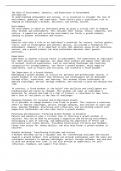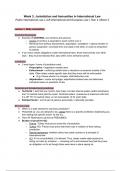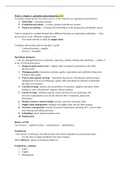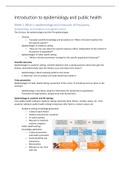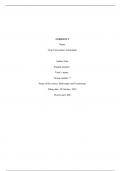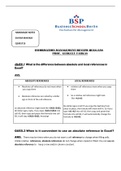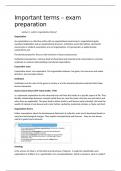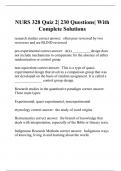Answers 2024
What is the difference between a parameter and a statistic? ** Answ** A parameter is a
numerical measurement describing data from a population. A statistic is a numerical
measurement describing data from a sample.
Consider these number assignments for category items describing electronic ways of expressing
personal opinions.
1 = Twitter; 2 = e-mail; 3 = text message; 4 = Facebook; 5 = blog
Are these numerical assignments at the ordinal data level or higher? Explain. ** Answ** No,
they are at the nominal level as there is no apparent ordering in the responses.
Consider these number assignments for category items describing usefulness of customer
service.
1 = not helpful; 2 = somewhat helpful; 3 = very helpful; 4 = extremely helpful
Are these numerical assignments at the ordinal data level? Explain. ** Answ** Yes, the data
has an ordering to its categories.
What about at the interval level or higher? Explain. ** Answ** No, while the data has an
ordering, and the data can be compared to each other, the differences don't mean anything.
What is the average miles per gallon (mpg) for all new hybrid small cars? Using Consumer
Reports, a random sample of such vehicles gave an average of 35.7 mpg.
(a) Identify the variable.
(b) Is the variable quantitative or qualitative?
,(c) What is the implied population? ** Answ** (a) miles per gallon
(b) quantitative
(c) all new hybrid small cars
Are data at the nominal level of measurement quantitative or qualitative? ** Answ**
qualitative
Categorize these measurements associated with student life according to level: nominal, ordinal,
interval, or ratio.
(a) Length of time to complete an exam
(b) Time of first class
(c) Major field of study
(d) Course evaluation scale: poor, acceptable, good
(e) Score on last exam (based on 100 possible points)
(f) Age of student ** Answ** (a) ratio
(b) interval
(c) nominal
(d) ordinal
(e) ratio
(f) ratio
If you were going to apply statistical methods to analyze teacher evaluations, which question
form, A or B, would be better?
Form A: In your own words, tell how this teacher compares with other teachers you have had.
Form B: Use the following scale to rank your teacher as compared with other teachers you have
had. ** Answ** Form B would be better because statistical methods can be applied to the
ordinal data.
,Explain the difference between a stratified sample and a cluster sample. (Select all that apply.)
** Answ** In a cluster sample, the clusters to be included are selected at random and then all
members of each selected cluster are included.
In a stratified sample, random samples from each strata are included.
Explain the difference between a simple random sample and a systematic sample. (Select all that
apply.) ** Answ** In a simple random sample, every sample of size n has an equal chance of
being included.
In a systematic sample, the only samples possible are those including every kth item from the
random starting position.
Consider the students in your statistics class as the population and suppose they are seated in four
rows of 10 students each. To select a sample, toss a coin. If it comes up heads, you use the 20
students sitting in the first two rows as your sample. If it comes up tails, you use the 20 students
sitting in the last two rows as your sample.
(a) Does every student have an equal chance of being selected for the sample? Explain.
(b) Is it possible to include students sitting in row 3 with students sitting in row 2 in your
sample?
Is your sample a simple random sample? Explain.
(c) Describe a process you could use to get a simple random sample of size 20 from a class of
size 40. ** Answ** a) Yes, your seating location and the randomized coin flip ensure equal
chances of being selected.
b) No, it is not possible with this described method of selection; No, this is not a simple random
sample. It is a cluster sample.
c) Assign each student a number 1, 2, . . . , 40 and use a computer or a random-number table to
select 20 students.
, Suppose you are assigned the number 1, and the other students in your statistics class call out
consecutive numbers until each person in the class has his or her own number.
(a) Explain how you could get a random sample of four students from your statistics class.
(Select all that apply.)
(b) Explain why the first four students walking into the classroom would not necessarily form a
random sample. (Select all that apply.)
(c) Explain why four students coming in late would not necessarily form a random sample.
(Select all that apply.)
(d) Explain why four students sitting in the back row would not necessarily form a random
sample. (Select all that apply.)
(e) Explain why the four tallest students would not necessarily form a random sample. (Select all
that apply.) ** Answ** (a) Explain how you could get a random sample of four students
from your statistics class. (Select all that apply.)
- Use a computer or random-number table to randomly select four students after numbers are
assigned.
(b) Explain why the first four students walking into the classroom would not necessarily form a
random sample. (Select all that apply.)
- Perhaps they are students with lots of free time and nothing else to do.
- Perhaps they are students that had a class immediately prior to this one.
- Perhaps they are excellent students who make a special effort to get to class early.
- Perhaps they are students that needed less time to get to class.
(c) Explain why four students coming in late would not necessarily form a random sample.
(Select all that apply.)
- Perhaps they are students that need more time to get to class.
- Perhaps they are students that had a prior class go past scheduled time.
- Perhaps they are lazy students that don't want to attend class.
- Perhaps they are busy students who are never on time to class.




